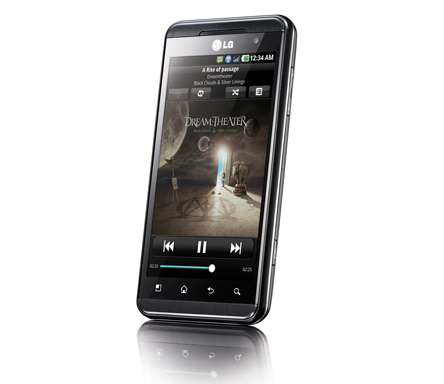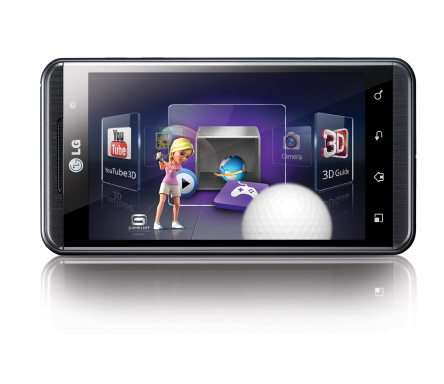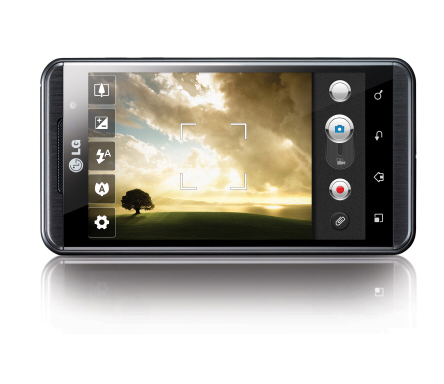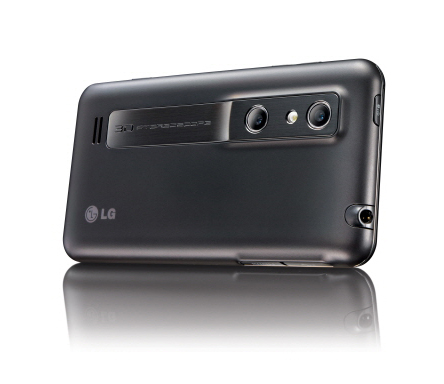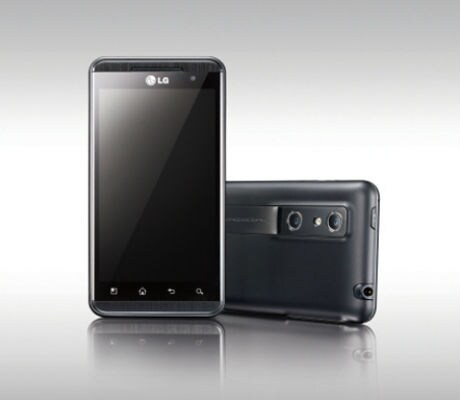
The so-called 3D television revolution seems to have largely passed consumers by. 3D technology in our living room feels gimmicky, gives us a headache and, above all, lacks content. 3D technology seems to have made a quantum leap from our big screen TVs to our smartphones. Since the screen is really small we are presented with glasses-free 3D. Is that little device in your pocket ready to go 3D or are you better off without the third dimension?
The LG Optimus 3D is aiming to answer the question.
Packaging and content
The LG Optimus 3D comes in a jazzy red rectangular box, the kind you wouldn't want to be seen with in public. This jazzy red box contains the unusually large smartphone, which at first glance looks as boring as a TV remote. The box also contains a pair of in-ear earphones, the micro USB cable that also doubles up as a charger.
Hardware and Styling
At first glance, the device has a candy bar form factor and is really big, almost as big as your hand. The screen is fairly large at 4.3-inches and covers most of the front. A shiny silver LG logo rests under the earpiece. Below the screen rest are four touch sensitive buttons. On the left of the device we have the micro USB port and the HDMI out port. The top has the 3.5mm headphones jack and the power/lock screen button. The right houses the volume rocker and the camera shutter button.
All-in-all, the device has curved edges and feels comfortable to hold but is very boring to look at. It feels a bit heavier than other devices too, weighing in at 168gms. You won't turn around and give the device a second look until you notice the two cameras resting at the rear of the device with 3D stereoscopic written next to it. Yes, the device houses two 5MP cameras with an LED flash and can shoot 2D still at a maximum resolution of 2592?194. In 3D mode however the device shoots stills at 3MP. The device also shoots video in 1080p at 30fps (2D) and 720p at 30fps (3D). The display is of course a 3D display, but doesn't work in 3D all the time. In fact, only a few specific features are enabled in 3D. The resolution of the screen too isn't very impressive at 480 x 800.
The rear of the device houses the memory card slot and the SIM card slot along with the1500mAh battery.
Under the hood, this beast is powered by a Dual-core 1GHz ARM Cortex-A9 processor, PowerVR SGX540 GPU and a TI OMAP4430 chipset. LG boasts that the processor is Tri-Dual Technology, which simply means a dual core processor, dual camera and dual channel memory.
The only advantage to the boring styling of the device is that it is ergonomically well built if you decide to use the device for long with its 3D features. This is because the device needs to be held at a particular angle for the glasses-free 3D to be effective.
Interface
If the device looks boring then the interface is Boring with a capital B. Boot up the device and the first thing that will disappoint you is that it runs on Android 2.2 and not 2.3. The device will be upgradable to 2.3. Like all Android devices, the LG Optimus 3D is heavily skinned. You simply slide up the screen to unlock it and are greeted by 7 home screens that you can flood with app shortcuts and widgets as per your preferences.
The drag down menu has the music player controls and the power controls that can be accessed with ease.
The bottom of the home screen has four buttons that cannot be customized i.e. phone, contact, message and application. The application-listing tab too is divided into three sections, the 3D apps, apps, and downloaded apps. The four touch sensitive buttons bellow the display are standard Android - menu, home, back and search.
The 3D interface on the other hand is a different ball game all together. All the 3D content can be accessed from the '3D space' app. This app gives you access to 3D games, the 3D camera, 3D Gallery, YouTube 3D and the 3D Guide.
The 3D interface of the device is really good and adds to the feeling of depth perception but at the same time also feels gimmicky. Hold the device at a particular angle and you will have the best 3D viewing experience without glasses on a mobile device. But shift in your seat and that experience is translated into blurry images that will give you an instant headache.
A good addition to the device is that you can not only view 3D content on it but also stream it to your 3D enabled TV via HDMI or DLNA.
With the exception of 3D, the overall interface of the apps, and the skinned Android 2.2 on the LG Optimus 3D is a lackluster experience. If you are looking for a more dynamic Android experience, consider the recently launched HTC EVO 3D.
Multimedia (3D as well)
The overall multimedia experience on the LG Optimus 3D is the same as on any other Android 2.2 device with the only addition being the 4.3-inch screen. Although the resolution could have been better, the 480 x 800 resolution display gets the job done pretty well. Apps look good, pictures and videos look vibrant.
In terms of the on-board apps, you get the usual mix of music and video player along with LG's Social+ social networking app. Nothing ground breaking here.
The 3D space is where the device truly excels. Sure there is lack of content and what you do get needs to be viewed at a specific angle, but whatever the device delivers, it delivers well. It does well in adding depth to the content you are viewing. It does well in giving you the illusion that stuff is popping out of the screen at you. And it does exceptionally well at giving you a headache if you get into the 3D content for too long.
The device comes preloaded with 4 3D games - Lets golf, Asphalt, Nova and Gulliver's Travels. The games give you the ability to control the level of 3D via a toggle. But naturally while playing, you are bound to move the device quite a bit jarring the 3D image and screen and inevitably ending up giving you - you guessed it, a headache. You can view, shoot and share your 3D content on YouTube 3D which is a nice addition. The content library on YouTube 3D isn't much and you'd get bored of it pretty quickly.
The on-board camera on the device does what it does well. But in 2D mode, a 5MP camera on such an expensive device seems a bit of a letdown especially since smartphones in the same price bracket offer you an 8MP shooter. The images produced in 2D are crisp, clear and even vibrant if the lighting conditions are good. But if you decide to rely on the on-board flash, you will end up with average photos.
The same can be said for 3D. In broad daylight you get good results and the images do add a feeling of depth perception. At night however, the results are bad.
The 3D video recording is surprisingly good. Videos in 720p HD in 3D look good on the device. Keep the device steady while shooting and you could get some great video from the device.
PC Sync & Market
Since this is an Android phone, syncing all your contacts is as simple as entering your Gmail, Facebook and Twitter accounts and the device is ready to use under 10 minutes.
The availability of a variety of paid and free apps in the Android market place ensure you never run out of fun things to do, but sadly there is nothing there to add value to the 3D capabilities of the device.
LG has also added its own LG World, which is an additional app store to the Android market. It houses apps and LG specific content like games. Although the noteworthy thing here must be that there is very little 3D specific content.
Performance
Apart from all the flashy multimedia, 3D and Internet capabilities, the phone needs to be able to make calls and send messages. In terms of call quality, the audio from the earpiece is loud, clear and well audible. The microphone too works well and even in a low network situation the conversation was smooth.
The preloaded keyboard is a standard QWERTY and same as the one you'd find on the LG Optimus 2X. The typing experience on the touch screen keyboard is great. The keys are well spaced out on the large screen and errors during typing were minimal.
Another advantage on the device was that web pages rendered rather fast along with full flash support. Websites with heavy flash integration opened well but scrolling, zooming and navigating these pages felt a bit sluggish.
Despite being a dual core processor smartphone with 512MB RAM, the devices performance felt a bit underwhelming under 3D use. The battery was drained in a matter of hours if you just play around with the 3D functionality.
If you keep 3D use to a minimal, you could get one day's battery life from the device.
Another problem with the device was that it heated up really fast. Leave it to charge for half an hour, and receive/make a call immediately after that and you will realize how hot the earpiece has become.
The in-ear earphones provided with the device are great for making calls. The audio is really loud and the mic picks up the voice very well. It is however horrible for listening to music. The headphones lack bass, but the midrange and vocals sound good.
Verdict
There are just two 3D smartphones available in the market today - the LG Optimus 3D and the HTC EVO 3D. In terms of ergonomic looks, UI and style, you are better off with the HTC. The 3D performance is however better on the LG. The depth perception, viewing angle and pictures taken in 3D look much better on the LG Optimus 3D.
Overall, it's hard to recommend either of the devices as 3D is still gimmicky on the small screen, lacks content and above all, there is very little 3D usability on the phone. For the most part, your everyday activities are in 2D.
For a price of Rs. 37,000, you are better of picking up the highest end Android smartphone from any manufacturer or an iPhone.
Pros
3D performance is good
Large screen
Good build quality
Cons
Lack of 3D content
Dull looks and LG skin
Battery life is poor
Ratings
Performance: 2.5
Price: 2
Ease of Setup: 4
Ergonomics: 3
Wow Factor: 2
Overall: 3
Information about Games review, Software Reviews, JAVA , Computer Tricks, Mobile Tricks , Gadgets review, TechNews , Apple, Windows, Android, iphone, symbian,wap,web and more
17 November 2011
LG Optimus 3D Review.........!!!!!
14 November 2011
List of Phones that will get Ice-Cream Sandwich
Google has officially unveiled the Ice Cream Sandwich i.e., Android 4.0 along with the launch of Samsung Galaxy Nexus. This ICS buzz has now made Android phone Geeks go crazy. Its a crazy and a very good deal indeed!
Asus came up with an announcement that their Padfone would come with Android 4.0 and it would be available in January 2012. That would be the near time when the Ice Cream Sandwich (ICS) would be made available for update on existing phones.
The following are the Android phones which I think should be able to run the Ice Cream Sandwich which is more stable and provide a better experience. We are not sure when these phones would receive the official firmware update but they are the front contenders for the Ice Cream Sandwich update first.
Samsung Nexus S
When the Samsung Galaxy Nexus debuts with Ice Cream Sandwich then why not its predecessor mobile phone? If you are expecting Ice Cream Sandwich update on existing phones then Nexus S is prime contender because it is the phone to start testing ICS.
Probably, when the Galaxy Nexus is available by this November, the ICS update for Nexus S should be taking it shape slated to be released soon.
Samsung Galaxy S II
The next phone which will get the Ice Cream Sandwich update is the Galaxy S II phone by Samsung Electronics. Galaxy S II is powerful phone with dual core 1.2 Ghz processor and impressive specifications to runs the Ice Cream Sandwich OS update smoothly. Already we have spotted Galaxy S II in China coming with NFC so there would be no problem & easily compatibility for Ice Cream Sandwich on S II phone.
Motorola Droid Razr
The Droid Razr by Motorola was launched just 12 hours earlier than the Galaxy Nexus launch and boards almost same specifications. Motorola team has already announced it that Droid Razr will be out with Ice Cream Sandwich soon and maybe they are playing with smart moves to keep in check with Samsung.
Droid Razr has got the right hardware but lacks Galaxy Nexus for most part of important update of NFC and Android Beam which one of the highlighting feature of Ice Cream Sandwich.Motorola Atrix 2
The Motorola Atrix 2 dual core 4G phone should be the next phone in the Motorola line up to receive the Ice Cream Sandwich update but it would be maybe by January next year the update of Ice Cream Sandwich is to be available on it.
Motorola Droid Bionic
The Motorola Droid Bionic with dual core 1 Ghz ARM Cortex A9 processor and OMAP chipset should be the next range of Android phone which would receive the Android update to 4.0. Motorola changed the chipset from Tegra to OMAP in order to pursuit the LTE and ICS in the near phone on this phone. Maybe it would be the first choice of device to receive the ICS update as Razr and Atrix 2 among the Motorola phones are the prime contenders for ICS update.
HTC Amaze 4G
The HTC Amaze 4G truly deserves the name as it has pretty decent software and has an amazing camera too. Also the hardware with which its built has killer specifications and chances that ICS would first come to HTC Amaze 4G when you talk about HTC phones to go with.
Since there is no official announcement which mobiles would receive the Ice Cream Sandwich, users are expecting too much, maybe but I would say let the Ice Cream Sandwich to be launched and then think about updates. For those who are unable to judge whether there mobile is upgradeable to Android 4.0 update, check back our blog.
The following are the few others mobile phones which might receive the Android 4.0 updates are LG Optimus 3D, Motorola Photo 4G, Motorola Atrix 4G, Samsung Droid Charge, myTouch 4G Slide.
Some of the phones launched in 2011 will get update and more won’t but its clear that high-end phones which would be announced from now should include Ice Cream Sandwich as the minimum operating system. Importantly we would see more custom ROM coming up which are built with modifications over the ICS.
13 November 2011
Windows 8 Tablet from Samsung Coming in 2012 2H............!!!!
Samsung is launching a range of new tablets in the second half of next year 2012. The new tablets will run the Windows 8 operating system .Windows 8 Tablet is scheduled to launch in 2012.
TFor those of you not aware of the Series 7, it is a tablet device with a slide out keyboard (pictured below) and is aimed at the enterprise user. With it having a physical keyboard and a tablet form factor, it’s ideal for those who want to switch between a multi-touch display in tablet mode or more of a laptop type of system.
Windows 8 was first revealed back in September and was received well in the media and amongst developers who began downloading it. The whole Windows 8 user interface is different than what we have seen before. It uses a Metro UI that makes using touch a lot easier.
TFor those of you not aware of the Series 7, it is a tablet device with a slide out keyboard (pictured below) and is aimed at the enterprise user. With it having a physical keyboard and a tablet form factor, it’s ideal for those who want to switch between a multi-touch display in tablet mode or more of a laptop type of system.
Windows 8 was first revealed back in September and was received well in the media and amongst developers who began downloading it. The whole Windows 8 user interface is different than what we have seen before. It uses a Metro UI that makes using touch a lot easier.
12 November 2011
Tranform your windows 7 appearance into Android.........!!!!!
Bored of the same Windows 7 theme? Or do you want to get a ‘Awesome Android‘ appearance on your system?
First have a look at all the amazing Android-Win7 OS! Its really ‘Awesome’.
![android transformation pack for windows 7 installation [JussBuzz.com] android transformation pack for windows 7 installation [JussBuzz.com]](http://jussbuzz.com/wp-content/uploads/2011/11/android-transformation-pack-for-windows-7-installation-JussBuzz.com_.png)
![windows 7 start up look after installing Android in windows 7 [JussBuzz.com] windows 7 start up look after installing Android in windows 7 [JussBuzz.com]](http://jussbuzz.com/wp-content/uploads/2011/11/windows-7-start-up-look-after-installing-Android-in-windows-7-JussBuzz.com_.png)
![windows 7 lock screen after installing android [JussBuzz.com] windows 7 lock screen after installing android [JussBuzz.com]](http://jussbuzz.com/wp-content/uploads/2011/11/windows-7-lock-screen-after-installing-android-JussBuzz.com_.png)
Desktop and Start Menu
![android start menu [JussBuzz.com] android start menu [JussBuzz.com]](http://jussbuzz.com/wp-content/uploads/2011/11/android-start-menu-JussBuzz.com_.png)
![Windows 7 to android view [JussBuzz.com] Windows 7 to android view [JussBuzz.com]](http://jussbuzz.com/wp-content/uploads/2011/11/Windows-7-to-android-view-JussBuzz.com_.png)
![Windows 7 to android desktop [JussBuzz.com] Windows 7 to android desktop [JussBuzz.com]](http://jussbuzz.com/wp-content/uploads/2011/11/Windows-7-to-android-desktop-JussBuzz.com_.png)
![latest android version for PC windows 7 operating system [JussBuzz.com] latest android version for PC windows 7 operating system [JussBuzz.com]](http://jussbuzz.com/wp-content/uploads/2011/11/latest-android-version-for-PC-windows-7-operating-system-JussBuzz.com_.png)
Its just a 26mb skin pack. Droid fan? What are you waiting for?
Get them here-
First have a look at all the amazing Android-Win7 OS! Its really ‘Awesome’.
Installation
![android transformation pack for windows 7 installation [JussBuzz.com] android transformation pack for windows 7 installation [JussBuzz.com]](http://jussbuzz.com/wp-content/uploads/2011/11/android-transformation-pack-for-windows-7-installation-JussBuzz.com_.png)
Windows-Android Startup
![windows 7 start up look after installing Android in windows 7 [JussBuzz.com] windows 7 start up look after installing Android in windows 7 [JussBuzz.com]](http://jussbuzz.com/wp-content/uploads/2011/11/windows-7-start-up-look-after-installing-Android-in-windows-7-JussBuzz.com_.png)
![windows 7 lock screen after installing android [JussBuzz.com] windows 7 lock screen after installing android [JussBuzz.com]](http://jussbuzz.com/wp-content/uploads/2011/11/windows-7-lock-screen-after-installing-android-JussBuzz.com_.png)
![android start menu [JussBuzz.com] android start menu [JussBuzz.com]](http://jussbuzz.com/wp-content/uploads/2011/11/android-start-menu-JussBuzz.com_.png)
![Windows 7 to android view [JussBuzz.com] Windows 7 to android view [JussBuzz.com]](http://jussbuzz.com/wp-content/uploads/2011/11/Windows-7-to-android-view-JussBuzz.com_.png)
![Windows 7 to android desktop [JussBuzz.com] Windows 7 to android desktop [JussBuzz.com]](http://jussbuzz.com/wp-content/uploads/2011/11/Windows-7-to-android-desktop-JussBuzz.com_.png)
![latest android version for PC windows 7 operating system [JussBuzz.com] latest android version for PC windows 7 operating system [JussBuzz.com]](http://jussbuzz.com/wp-content/uploads/2011/11/latest-android-version-for-PC-windows-7-operating-system-JussBuzz.com_.png)
Its just a 26mb skin pack. Droid fan? What are you waiting for?
Get them here-
DOWNLOAD FOR WINDOWS 7 x86
http://www.deviantart.com/download/261282717/android_skin_pack_1_0_x86_by_hameddanger-d4bk719.zip
DOWNLOAD FOR WINDOWS 7 x64
http://www.deviantart.com/download/261282844/android_skin_pack_1_0_x64_by_hameddanger-d4bk74s.zip
07 November 2011
China Wants Its Hands All Over Your Internet....!!!!
China faces US cyber-spying accusations after proposing a “Code of Conduct” to the UN and renewing its internal internet censorship.
New revelations about industrial cyber-spying and internal crackdowns on micro-blogs call into question China’s motives to exert control over internet governance - and behave responsibly outside its borders in cyberspace.
If I was China right now, I’d be SO embarrassed.
I mean, if I had just turned in a big report to the U.N. proposing an internet “Code of Conduct” under the guise of security and fighting cyber crime, and then the U.S. Office of the National Counterintelligence Executive issued a report saying I was doing the very things that would violate that proposal…
Well, it would be way worse than that time I showed up to the first day of 8th grade homeroom and Becky the cheerleader was wearing the exact same blue Banana Republic sweater that I was.
I’m in no way trying to minimize what’s going on here, but it’s difficult not to think The Onion is orchestrating China’s PR around its intent to make sure everyone on the internet is dressed appropriately.
I’m actually not taking the analogy too far. Let me explain.
Last week the Chinese government stepped up monitoring of the internet inside its borders. Hard to believe, right? It started with an anti-porn and anti-vulgarity censorship campaign on mobile devices back in 2009, but this new crackdown is on China’s many popular micro-blogging sites (Twitter is a micro-blogging site).
...........................................................................................................................................................still there.....
New revelations about industrial cyber-spying and internal crackdowns on micro-blogs call into question China’s motives to exert control over internet governance - and behave responsibly outside its borders in cyberspace.
If I was China right now, I’d be SO embarrassed.
I mean, if I had just turned in a big report to the U.N. proposing an internet “Code of Conduct” under the guise of security and fighting cyber crime, and then the U.S. Office of the National Counterintelligence Executive issued a report saying I was doing the very things that would violate that proposal…
Well, it would be way worse than that time I showed up to the first day of 8th grade homeroom and Becky the cheerleader was wearing the exact same blue Banana Republic sweater that I was.
I’m in no way trying to minimize what’s going on here, but it’s difficult not to think The Onion is orchestrating China’s PR around its intent to make sure everyone on the internet is dressed appropriately.
I’m actually not taking the analogy too far. Let me explain.
Last week the Chinese government stepped up monitoring of the internet inside its borders. Hard to believe, right? It started with an anti-porn and anti-vulgarity censorship campaign on mobile devices back in 2009, but this new crackdown is on China’s many popular micro-blogging sites (Twitter is a micro-blogging site).
...........................................................................................................................................................still there.....
05 November 2011
Google: Android 4.0 to be open sourced in "coming weeks"
Summary: Google will make its Android 4.0 dubbed “Ice Cream Sandwich” available to the open source community in the coming weeks and is designed to fuel Google’s big push in both the smartphone and tablet war against Apple. Google’s planned purchase of Motorola’s Mobility unit — the most successful Android smartphone and tablet supplier — will also likely help if it ultimately musters government approval
Google’s next generation Android 4.0 — code named “Ice Cream Sandwich” — will be available to the open source developer community in weeks, one company spokesman said yesterday.
And yes, Ice Cream Sandwich is designed to re-unify the Android code base for smartphones and tablets, and will likely please more in the open source community, the spokesman indicated.
“It will be open sourced in the coming weeks, yes,” said Randall Sarafa, a spokesman for Google. “Correct. No, Honeycomb was not [open sourced].”
“ICS will be open sourced, and yes, ICS is meant to reunify and provide *one* release for both tablets and smartphones,” Sarafa wrote in another one of several e-mails written in response to questions from this blogger about Google’s open source efforts with respect to Android.
Honeycomb, the previous Android 3.0 code base optimized for tablets, was subject to some criticism for its potential to fork Android, and for not being available to open source developers.
“”Ice Cream Sandwich is Android 4.0, and it is one release for tablets, smartphones and everything in between. That means that tablets going forward can run on Ice Cream Sandwich as can phones, so it is an update for both tablets and smartphones,” Sarafa said.
This blogger wanted to talk to Google about the potential for ICS to compete more aggressively against iPad and iPhone 4 s but was told that a tablet spokesman was not available.
How about a spokesman from Motorola?
Google announced plans to purchase Motorola’s mobility business unit for $12.5 billion earlier this year. Motorola is the largest and most successful hardware supplier of Droid phones and Android-based Xoom tablets.
01 November 2011
No, Facebook Is Not Ruining Your Grades [STUDY]...!!!

“Facebook use in and of itself is not detrimental to academic outcome,” says study author Reynol Junco, a professor at the Lock Haven University of Pennsylvania. “It depends how it’s used.”
The study, published last week in Computers in Human Behavior, analyzes 1,839 college students’ survey data about Facebook use and actual grades (as opposed to self-reported grades). It also takes into account students’ high-school GPAs.
On average, students say they spend 106 minutes on Facebook per day. Each increase of 93 minutes beyond 106 minutes correlates with a GPA decrease of .12 grade points — statistically significant, but not dramatic when applied to a real-world situation.
“You have to spend an inordinate amount of time on Facebook for it to be related to GPA in a way that is shocking,” Junco says.
It makes sense that a drop in grades would be caused by students who let Facebook time cut into study time. But the data shows no correlation between time spent on Facebook and time spent studying.
All Facebook activities do not have the same relationship with grades. Posting status updates and using Facebook chat generally mean a lower GPA, while checking to see what friends are up to and sharing links suggest a higher GPA. In other words, social Facebook activities were correlated with lower grades and information-related Facebook activities were correlated with higher grades.
This doesn’t necessarily mean forgoing Facebook status updates and chat is likely to improve a student’s grades. Nothing in the study implies cause and effect. Instead, it seems that what’s important about Facebook in an educational context has very little to do with how much time you spend on it.
Junco thinks there are ways Facebook can be used effectively in an educational context — which is why he sets up Facebook groups for each of his classes to continue discussion online.
“What I like best about it is that we’re using a technology that students already use,” he says.
Subscribe to:
Comments (Atom)

